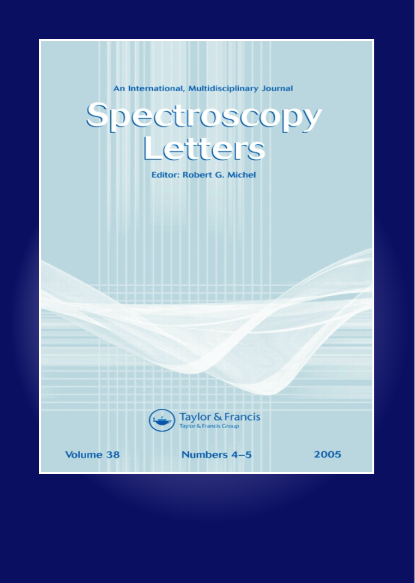软x射线和基于磁化率的磁共振成像绘制苹果中的铁分布:初步结果模拟铁在缺水或脱水的生物组织中的储存
IF 1.6
4区 化学
Q3 SPECTROSCOPY
引用次数: 0
摘要
摘要放射科对温室气体做出了重大贡献,包括向环境释放有毒成像造影剂。我们觉得放射学也有一些光谱和成像工具,可以用于监测和支持更清洁的环境目标。目前的手稿是第一份通过对生物组织中含量较低但在组织结构和功能中起关键作用的生物金属进行非侵入性成像,促使放射学朝着这个方向发展的手稿之一。传统的分析工具大多是侵入性的,不能表征生物金属的天然氧化态。我们选择了富含金属的水果的碳水化合物基质,并优化了两种非侵入性成像方法,以检测样品随时间干燥时生物金属分布的变化。它补充了我们之前在《断层摄影杂志》上的工作,该工作证明了特定的放射性造影剂的分解会导致镧系元素和碘化化合物流入农产品,并通过螯合和转运改变体内平衡。我们观察到,在20–30 keV范围,即临床X射线的低端,商业乳腺X射线检测仪可以检测碱、碱土、,以及水果样品中的过渡金属,而不管它们的氧化状态如何,使用适当的X射线过滤器利用优先光电吸收,而高场磁共振成像仪(MRI)由于其加速质子T2*衰变的能力,可以定位某些矿物的顺磁状态,并在这里用于研究脱水不同阶段的生物组织。我们还观察到,对于部分干燥的苹果,铁分布从皮层向果核的中心径向变化,这表明随着保湿作用的减弱,孔隙率发生了变化。然而,目前我们的方法无法令人信服地将顺磁性生物金属的磁化率效应与脱水过程中孔隙率变化的磁化率影响区分开来。我们认为这项工作有两个新的方面:首先,MRI和X射线可以用于绘制富含顺磁性物质物种的分布图,其次,在干旱地区种植的农产品或作物的热处理过程中,离子传输可以通过低能量X射线和高场MRI监测生物金属分布的变化。体内应用可能利用天然生物金属的MR敏感性来定位神经退行性变中的异常铁分布。本文章由计算机程序翻译,如有差异,请以英文原文为准。
Soft X-ray and susceptibility based magnetic resonance imaging to map iron distribution in apples: initial results to model iron storage in water-deficient or dehydrated biological tissue
Abstract Radiology departments have contributed significantly to greenhouse gases including release of toxic imaging contrast media to environment. We feel Radiology also has several spectroscopy and imaging tools that may apply to monitor and support cleaner environmental goals. The current manuscript is one of the firsts to prompt Radiology to move in that direction by non-invasive imaging of bio metals that are less abundant in biological tissues but play key roles as co-factors in tissue structure and function. Conventional analytical tools are mostly invasive and cannot characterize the native oxidation states of bio metals. We chose carbohydrate matrix of metal-rich fruits and optimized two non-invasive imaging methods to detect changes in bio metal distribution as the samples were allowed to dry over time. It complements our prior work in Tomography Journal that demonstrated breakdown of specific radiological contrast media causing inflow of lanthanides and iodinated compounds to agricultural products and alter homeostasis by chelation and transmetallation. We observed that in the 20–30 keV range, that is at low end of clinical X-ray, commercial mammography detectors can detect alkali, alkaline earth, and transition metals in fruit samples irrespective of their oxidation states with appropriate X-ray filters utilizing preferential photoelectric absorption while high field magnetic resonance imagers (MRI) can localize paramagnetic states of certain minerals due to their ability to accelerate proton T2* decay and was used here to study biological tissues at different stages of dehydration. We also observed a central, radial shift of iron distribution from cortex toward the core for partially dried Apples indicative of porosity changes with de-moisturization. However, at this time our approach is unable to convincingly separate the susceptibility effects of paramagnetic bio metals from susceptibility effects of porosity changes during dehydration. We believe this work has two novel aspects: first, that MRI and X-ray could be used for complementary roles to map distribution of paramagnetics rich species, and secondly, ionic transport during heat processing of agricultural products or crops grown in arid land can be monitored for altered bio metal distribution by low energy X-ray as well as by high field MRI. In vivo applications may be possible to exploit MR susceptibility of native bio metals to localize abnormal iron distribution in neurodegeneration.
求助全文
通过发布文献求助,成功后即可免费获取论文全文。
去求助
来源期刊

Spectroscopy Letters
物理-光谱学
CiteScore
2.90
自引率
5.90%
发文量
50
审稿时长
1.3 months
期刊介绍:
Spectroscopy Letters provides vital coverage of all types of spectroscopy across all the disciplines where they are used—including novel work in fundamental spectroscopy, applications, diagnostics and instrumentation. The audience is intended to be all practicing spectroscopists across all scientific (and some engineering) disciplines, including: physics, chemistry, biology, instrumentation science, and pharmaceutical science.
 求助内容:
求助内容: 应助结果提醒方式:
应助结果提醒方式:


